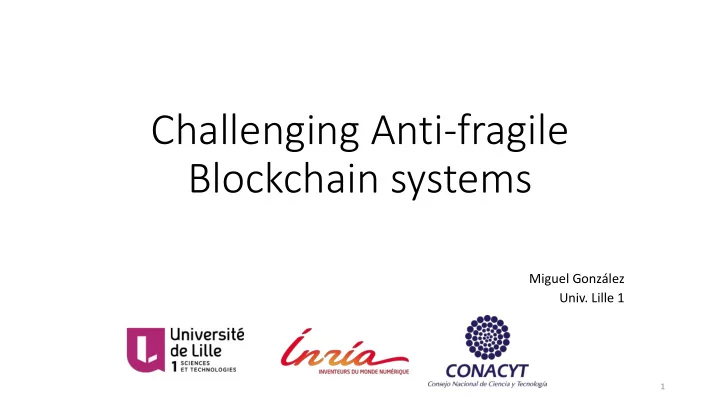

Challenging Anti-fragile Blockchain systems Miguel González Univ. Lille 1 1
What is Anti-fragile? Harmed by Resilient to Benefits and Learns disorder disorder from disorder 2
Systems considered anti-fragile • Financial system • Human Body • Restaurant system • Healthcare system • Netflix as a company and its architecture • Bitcoin 3
Industries are in interested in Bitcoin • Banks • Music • Retail • Supply Chain • Manufacturing • But they see issues with the Bitcoin protocol, so they are investing in Blockchain 4
What is a Blockchain ? • A chain (sequence) of blocks of transactions • Each block consists of a number of transactions • A Blockchain is just a Distributed Database with: • Added security • Consensus • Data immutability • Smart Contracts (chaincode) • Authorization & Authentication • Record keeping 5
Traditional vs. Blockchain 6
Proof of Work (Bitcoin, Ethereum) State machine replication (Hyperledger, Corda) Membership Permissionless Permissioned User IDs Decentralized, Anonymous Centralized, all (Decentralized protection by PoW Nodes know all other Nodes compute/hash power) (Centralized IDM protects against Sybil attacks) Scalability Excellent, >100k Nodes Verified up to few tens (or so) (no. of Nodes) Nodes Throughput 7 tx /sec upper bound (Bitcoin) >10k tx /sec with existing implementations in software Power efficiency >1 GW (Bitcoin) Good (commodity hardware) Forks in Possible (leads to double Not possible blockchain spending attacks) Consensus No Yes, with BFT protocols Cryptocurrency Yes No Anti-Fragile Yes ??? 7
Problem • Important institutions are rushing to implement Blockchain. • Most implementations are untested and will likely have bugs. • Hypothesis: Removing key elements from anti-fragile system like Bitcoin will make it more fragile • What can I use to test Distributed Systems like Blockchains? • Formal methods • Failure injection • Instrumentation 8
Related Work • Random fault injection (Basiri et al., 2016) • Byzantine fault injection (Martins et al., 2013) • Lineage-driven fault injection (Alvaro et al., 2015) 9
Motivation • Blockchain technologies do not have any fault injection frameworks • Blockchain tech hasn’t been formally verified • Available fault-injection solutions do not cover Byzantine failures 10
My proposal • Systematic Byzantine Failure Injection for Blockchain technology. • Byzantine faults in consideration • Crash • Message Delay • Corrupt Packets • System Overloading • Systematic and recoverable injection • Fault Type • Fault Parameters (fault duration, delay time, # clients) • Blockchain and protocols in consideration • Hyperledger Fabric - PBFT & Kafka • Corda - BFT-Smart & RAFT 11
Architecture for Failure Injection 12
Challenge • Create a general solution to inject Byzantine failures into Blockchains despite their differences: • Language • Architecture • Protocol 13
Next Steps • Complete implementation of the Failure injector • Perform large scale experiments with Hyperledger Fabric and Corda • Introduce Smart failure injection like LDFI • Start the base line for a Benchmark for permissioned Blockchain 14
END • Problem: Recent interest in Blockchain technologies that remain untested. They lack good testing framework to verify and compare them. We don’t know if they are anti-fragile. • Contribution: Systematic Byzantine Failure Injection for Blockchain technology. Aims to help benchmark Blockchain technologies and endow them with anti-fragility if used in production. 15
Example of Failure • http POST http://injector:8080 cmd=“WAIT” period=500 type=“DELAY” • http POST http://injector:8080 cmd=“START” type=“DELETE” path=“/var/lib/hyperledger/data” • http POST http://injector:8080 cmd=“WAIT” type=“DOWN” iface=“eth0” 16
Recommend
More recommend